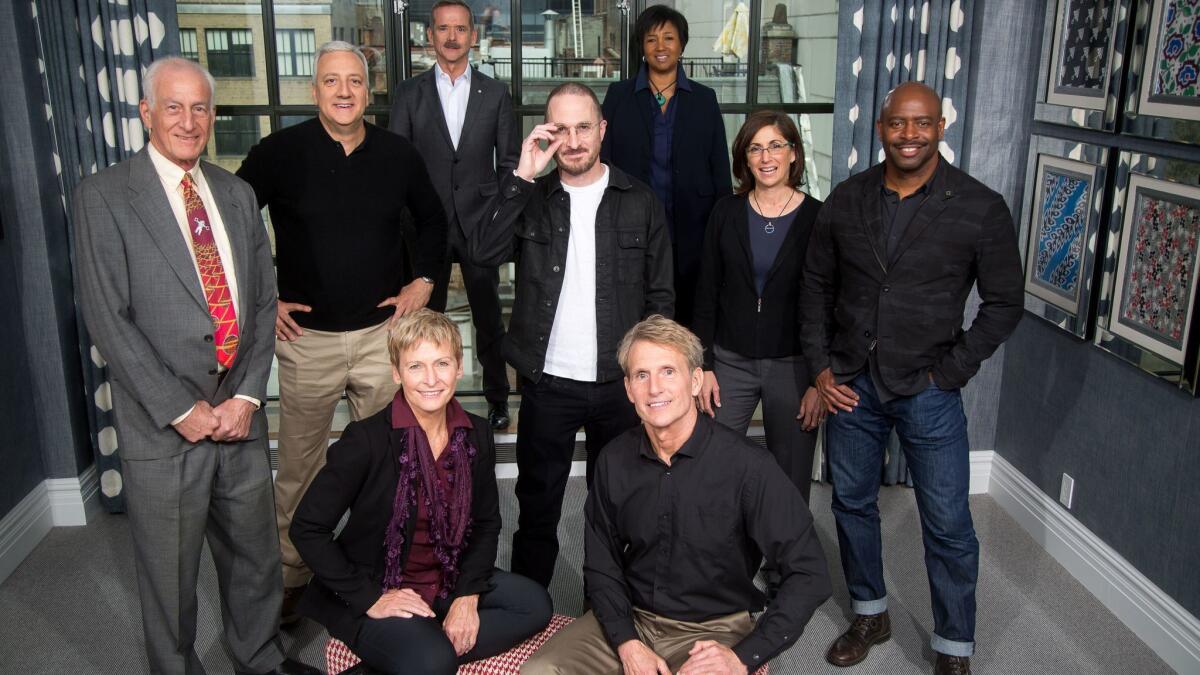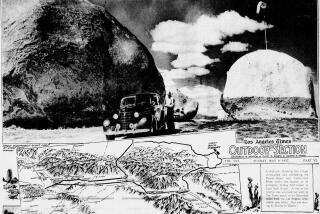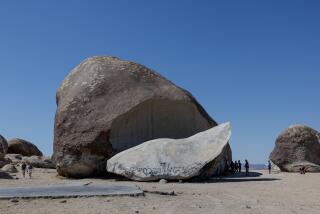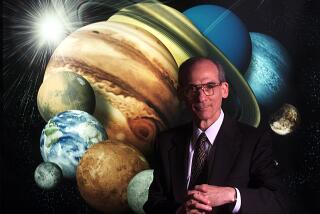‘One Strange Rock’ looks at planet Earth with ‘mother!’ director Darren Aronofsky

In director Darren Aronofsky’s new science-based thriller, Will Smith plays himself — a carefree guy living in an incredibly complex and fragile environment that he takes for granted. And no, that rarefied space is not the illustrious stratosphere of Hollywood celebrity.
It’s planet Earth, where a spec of dust from East Africa or a dew drop from the Amazon basin has as much impact on the survival of the human race as a violent volcanic eruption or galactic debris storm.
If this sounds like a sequel to Aronofsky’s last film, “mother!,” the esoteric parable about man’s abusive relationship with Mother Earth (played by Jennifer Lawrence), it’s not. “mother!” was one strange movie. His newest venture is “One Strange Rock.”
The 10-part National Geographic docu-series pairs cinematic storytelling with earth science, turning the commonplace “global warming, time’s running out” narrative into a graceful, nuanced look at the amazing things happening below our feet and above our heads.
Narrated by Smith, the series, which debuts March 26, is Aronofsky’s first foray into television. The filmmaker’s fascination with plumbing the deep recesses of the human psyche (he directed the Oscar-winning “Black Swan”) spans the series in unexpectedly intimate interviews with eight veteran astronauts. Their gravity-defying perspectives cast the Earth in a whole new light.
“Something remarkable happened to all the astronauts,” Aronofsky said during a recent interview from New York, where he was promoting the series. “Some people would call it spiritual, but they all have a reaction to leaving the atmosphere and looking back on it.”
He added, “You know, a lot of astronauts say that when we went to the moon, we actually discovered the Earth. They all come back as very committed environmentalists who no longer see themselves as being from Iowa or being from the United States. They see themselves as earthlings and see how everything is interconnected.”
Aronofsky described the astronauts’ emotional accounts of their time away from Earth as “spiritual transformations” that he and co-executive producer Jane Root wanted to illustrate by “going to all of these incredibly beautiful locations around the planet and photographing them like they’ve never been photographed before to remind us that this planet is filled with awe.”
The pilot episode features NASA astronaut Peggy Whitson, the first female commander of the International Space Station, recalling her first impressions from 250 miles above the Earth: “It’s like I lived my whole life in a semi-dark room, and then somebody flipped on the lights.”
Showing science in a new light is National Geographic’s strategy in series such as “One Strange Rock.” The show follows a string of productions in which the network has presented subjects many associate with tedious stretches in a stuffy classroom and given them dramatic, narrative-driven makeovers. The strategy symbolizes the network’s push for highly produced programming that features A-level talent in front of and behind the camera, that rethinks what science looks like on TV.
“Smart and purposeful and entertaining are not mutually exclusive attributes,” says Courteney Monroe, the chief executive of National Geographic Global Networks who oversees global programming, operations and marketing. “‘One Strange Rock’ is a perfect example of that. It’s a mind-bending, visually spectacular ride that you really learn a lot from. None of this stuff should feel like homework. It’s got to be entertaining first, and that’s why we worked with [people like] Darren and Neil deGrasse Tyson on ‘Star Talk’ and Leonardo DiCaprio on ‘Before the Flood.’”
The network’s “Genius” anthology returns April 24 with “Picasso,” a drama co-produced by the Oscar-winning team of director Ron Howard and producer Brian Grazer (“A Beautiful Mind”) and starring Antonio Banderas. The series, which depicts the personal stories of groundbreaking, historical figures, debuted last year with “Einstein.”
The International Space Station serves as the central hub in “One Strange Rock,” where footage shot from the craft shows the phenomenon of, say, fog or dust storms from space before the camera moves in and takes viewers around the globe, from the majestic sand dunes of Morocco to Mars-like salt flats in Ethiopia to underground water caverns in the Yucatan. The footage is often dramatic and sweeping in the vein of Discovery’s “Planet Earth,” and each episode arrives with a new theme that when woven together tells the 4.5 billion-year-old story of this place we call home.
Sexy episode titles like “Gasp,” “Storm” and “Shield,” which sound more like “X-Men” spin-offs than science fare, explore how oxygen is made and sustained, or how the Earth was created, via eye-catching footage and lively interviews with experts. And Smith’s casual presence immediately lets viewers know that this is not your parents’ David Attenborough special.
“When I saw the first images Darren put together, I was absolutely stunned,” Smith said of the early stages of “One Strange Rock.” “As I began to work and talk to him about the project — the depth and the intricacy with which he, National Geographic and his team [Protozoa] were going into the science and the beauty of our planet — all of a sudden, I was overwhelmed by how much of a miracle life is.”
Even with a wide-ranging career that has stretched from “The Fresh Prince of Bel-Air” to portraying Muhammad Ali and beyond, Smith wasn’t an obvious choice for Science Show Host, and that was exactly why he was pursued for the project. Aronofsky and coproducer Root wanted a familiar, everyday-man presence to guide audiences through subject matter often regarded as daunting or academic.
Science-minded academics with a natural inclination toward complex theory may roll their eyes at television’s glossy treatment of what they may know as basic concepts. But consider that a 2015 study of 75 developed nations ranked American teens 25th in science literacy behind countries those same kids probably couldn’t find on a map (Estonia, anyone?).
After the high-profile space race of the 1960s, public interest and government funding dropped off with each ensuing decade. But “Apollo 13” and other films about space travel began to recapture audience’s imaginations — and reminded America of a time when we reached for the stars. Now, the cosmos is once again portrayed as a wild frontier to be conquered in “Gravity,” “Interstellar” and “The Martian.”
“I mean, ‘Lost in Space’ is coming back on as a TV series,” said Canadian astronaut Chris Hadfield, who commanded the International Space Station and spent a total of 166 days in space. Hadfield, who spoke by phone from New York, is featured prominently in “One Strange Rock.”
He believes advances in technology have also contributed to a renewed interest in what lies beyond. “We suddenly have a connectivity like we’ve never had before, where we can use social media to bring people onboard with us,” Hadfield said. “The experience stops being clinical and remote and esoteric, and instead becomes part of the normal fabric of what people see and access every day. And I think that has had a big impact. People feel that it’s relevant and interesting.”
“One Strange Rock” does not hammer the point home that we need to preserve our planet. The idea is intrinsic to every episode, woven into examples of how nature has shaped humankind, and how it can destroy it in one fell swoop.
In one scene, desert Bedouins who make a living selling meteorite fragments scour three-story-high sand dunes for the precious black material. It’s in high demand by scientists who hope to better understand our past in order to preserve our future.
In another spot, a diver in the Yucatan brings the cameras deep into underwater caverns created by asteroids that precipitated the Ice Age. The scene is at once beautiful and a terrifying reminder of our collective fragility.
“Our world was born out of violence and storms [that still rage]… ,” Smith says in the “Storm” episode. “Every day, the Earth plows through about 40 tons of material in space. There’s so much activity, so much action, and our planet is right in the middle of it. It’s a storm that could kill us, but without it, we wouldn’t be here at all.”
He then explains how a “bull’s-eye strike” on a large sulfur reserve sent billions of tons of polluting gas into the atmosphere, which blocked out the sun, which caused the Ice Age, which killed the dinosaurs ... and it all eventually led to us.
“A tale of destructive good fortune,” says Smith.
More to Read
The complete guide to home viewing
Get Screen Gab for everything about the TV shows and streaming movies everyone’s talking about.
You may occasionally receive promotional content from the Los Angeles Times.







